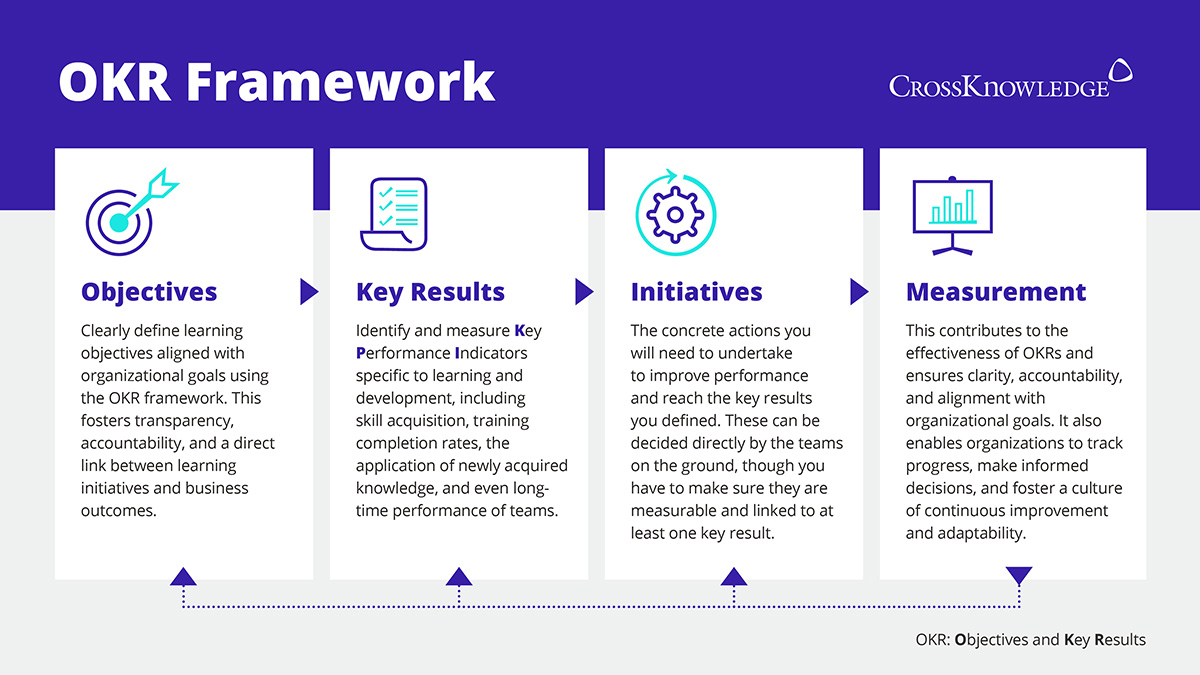As an L&D professional, you know that traditional methods of assessing the impact of learning initiatives can fall short in providing real-time, actionable insights into employee development and organizational growth. In an ever-changing learning landscape, establishing a clear connection between learning objectives and overarching business Key Performance Indicators (KPIs) remains a persistent challenge.
While the influx of information can be overwhelming, there are ways that you can effectively interpret and utilize data to enhance learning outcomes.
How adopting an Objectives and Key Results framework can help
Most L&D leaders identify and measure Key Performance Indicators specific to learning and development when crafting their strategy. Ideally this includes tracking metrics such as skills acquisition, training completion rates, and the application of newly acquired knowledge in the workplace. It can even go as far as measuring long-time performance of teams through regular assessments over a longer period of time.
But you can take it one step further by connecting your learning objectives (aligned with organizational goals) and KPIs with your learning initiatives to foster transparency, accountability and adaptability. Simply put, the OKR framework creates a direct link between learning initiatives and business outcomes to generate clear and actionable metrics.
What exactly is an Objectives and Key Results framework?
If you’re not familiar with OKRs, you might be wondering how they differ from KPIs. In fact, Key Performance Indicators are an integral part of the Objectives and Key Results framework. They are a necessary step to help you tie your objectives to your learning initiatives, which in turn gives you the critical data you need to move forward with purpose.
Working towards KPIs can reinforce a positive and goal-oriented culture that motivates individuals and teams because hard work is being measured and recognized. And by quantifying key results, organizations can directly link their efforts to desired outcomes, promoting a strategic alignment between different levels of the organization.
Additionally, having the right measurements helps make decisive resource allocations. Organizations can assess which initiatives are delivering the desired results and distribute resources accordingly to optimize efficiency, maximize impact and align with broader business goals.
So where do you begin?
- Start with your Objectives.
Begin by defining only the learning objectives that are aligned with organizational goals. By adding them to the OKR framework, you’ll form a direct link between your objectives and business outcomes which can foster transparency and accountability. - Next determine your Key Results.
Here you identify and measure Key Performance Indicators specific to learning and development, including skills acquisition, training completion rates, application of newly acquired knowledge, and even the long-term performance of individual teams. - Then add your Initiatives.
By initiatives we mean the concrete actions you will need to undertake to improve performance and reach the key results you’ve just defined. They can be decided by the teams on the ground, although you’ll need to make sure these initiatives are measurable and linked to at least one key result. - The last step is Measurement.
This contributes to the effectiveness of OKRs and ensures clarity, accountability, and alignment with organizational goals. It also enables organizations to track progress, make informed decisions, and foster a culture of continuous improvement and adaptability.

Why Measurement is a crucial aspect of OKRs
Measurement within this framework provides clarity and accountability on your intended outcomes because your objectives are specific and well-defined. It helps avoid miscommunication by ensuring that everyone understands (and agrees on) what success looks like. When your key results are quantifiable, it becomes evident whether they have been achieved or not, and this fosters a sense of responsibility and collaboration among teams and stakeholders.
The clear metrics provided by an OKR framework allows organizations to be adaptable by creating a culture of continuous improvement. While tracking progress, leaders can assess whether the chosen objectives are realistic and swiftly adjust strategies to align with changing circumstances. And when progress is quantified, it becomes easier to communicate with stakeholders, employees, and other relevant parties about the organization’s performance and achievements.
Start using an OKR framework today to leverage your data effectively
This is a very challenging time for you as L&D professionals. Between rapid technological change, the increasing complexity of the business world, and the constant flow of data, it’s difficult to design training that meets organizational needs in the moment. Combining OKRs and KPIs with critical data analysis gives you the power to address even the toughest challenges, boosting L&D impact on organizational success in an era of continuous evolution.